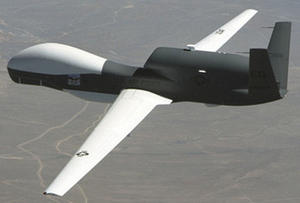UAV updateNew strategy for UAVs: emulate the soaring approach of peregrine falcons
UAVs could fly for longer using less power if they copied the counter-intuitive flying patterns of peregrine falcons, say researchers; falcons, instead of spiraling in one direction to stay with a single thermal, constantly change the direction of their spirals

Global Hawk can improve its flight time using thermals // Source: defenseindustrydaily.com
Thermals are warm regions of the atmosphere that move upward more quickly than the rate of descent of a glider or bird. Consequently, pilots and birds who can find and exploit thermals, can stay airborne for longer, while using less fuel.
It is no surprise then that the designers of unmanned aerial vehicles (UAVs) are keen to find strategies for finding and exploiting thermals. Glider pilots already have a simple set of rules developed by the long distance glider pilot Helmut Reichmann (who died in a mid-air collision in 1992). Pilots apply these so-called Reichmann rules when they are climbing in a spiral due to a thermal. The rules are these:
- If the climb improves, widen the spiral by decreasing the banking angle.
- If the climb deteriorates, tighten the spiral by increasing the banking angle.
- And if the climb remains constant, keep the banking angle constant.
Technology Review reports that this works reasonably well but has important limitations, particularly when there is thermal noise (that is, turbulence) in the atmosphere. Turbulence can fool fliers into thinking they are in a thermal when in fact they are not; and vice versa, fooling them into thinking they are not in a thermal when they are.
Of course, there are various other strategies. Most recently, researchers have begun to use GPS data to log their flight paths and to measure the rate of climb for various banking angles. They can then use this information to estimate the centre of any thermal and so exploit it more fully.
TR notes that the trouble with this approach is that it is computationally expensive and power hungry. This is a crucial factor for UAVs which have limited on board power.
Today, Zsuzsa Ákos at Eötvös University in Hungary and a few pals suggest another approach inspired by videos and GPS tracking of peregrine falcons in flight. It turns out that these masters of thermal soaring employ a counter-intuitive strategy: instead of spiraling in one direction to stay with a single thermal, they constantly change the direction of their spirals.
At first glance, that seems odd. Change the direction of your spiral and you immediately fly out of a thermal. Ákos and colleagues, however, have simulated this strategy and say there is a method in this madness.
The key is to recognize that the atmosphere is filled with thermals that are distributed in 3D space in complex ways. According to their simulation, the reason why the direction change works so well is that it allows the flier to sample the volume of the atmosphere more effectively, making it more likely that it will find a better thermal. Crucially, this works particularly well when turbulence is present.
The new strategy is computationally simple and so requires little power to implement. So the thinking is that UAVs could fly for longer, using less power, if they copied the falcon’s flying behavior.
TR writes that this is work in progress, however. Exactly how much better direction changing is over, say, the Reichmann rules is not yet clear. Ákos and colleagues say their simulations indicate that direction changing is superior when the thermals have a radius of 100 to 200 meters. They say, though, that the Reichmann rules seem to be better for larger thermals, where turbulence is easier to spot.
“Clearly, more work is needed, not least in the study of how birds solve this problem. Nature has had a little longer than UAV engineers to work on this problem. And although computer scientists have begun to use an evolutionary algorithm approach on this task, there is clearly much more to learn,” TR concludes.
— Read more in Zsuzsa Ákos et al., “Thermal soaring flight of birds and unmanned aerial vehicles,” arXiv:1012.0434v1 [physics.bio-ph] (2 December 2010) (DOI: 10.1088/1748-3182/5/4/045003)
